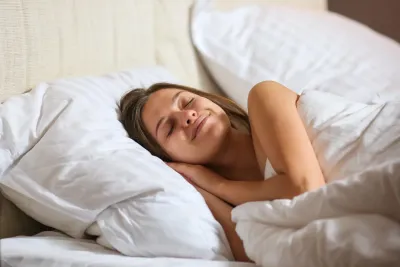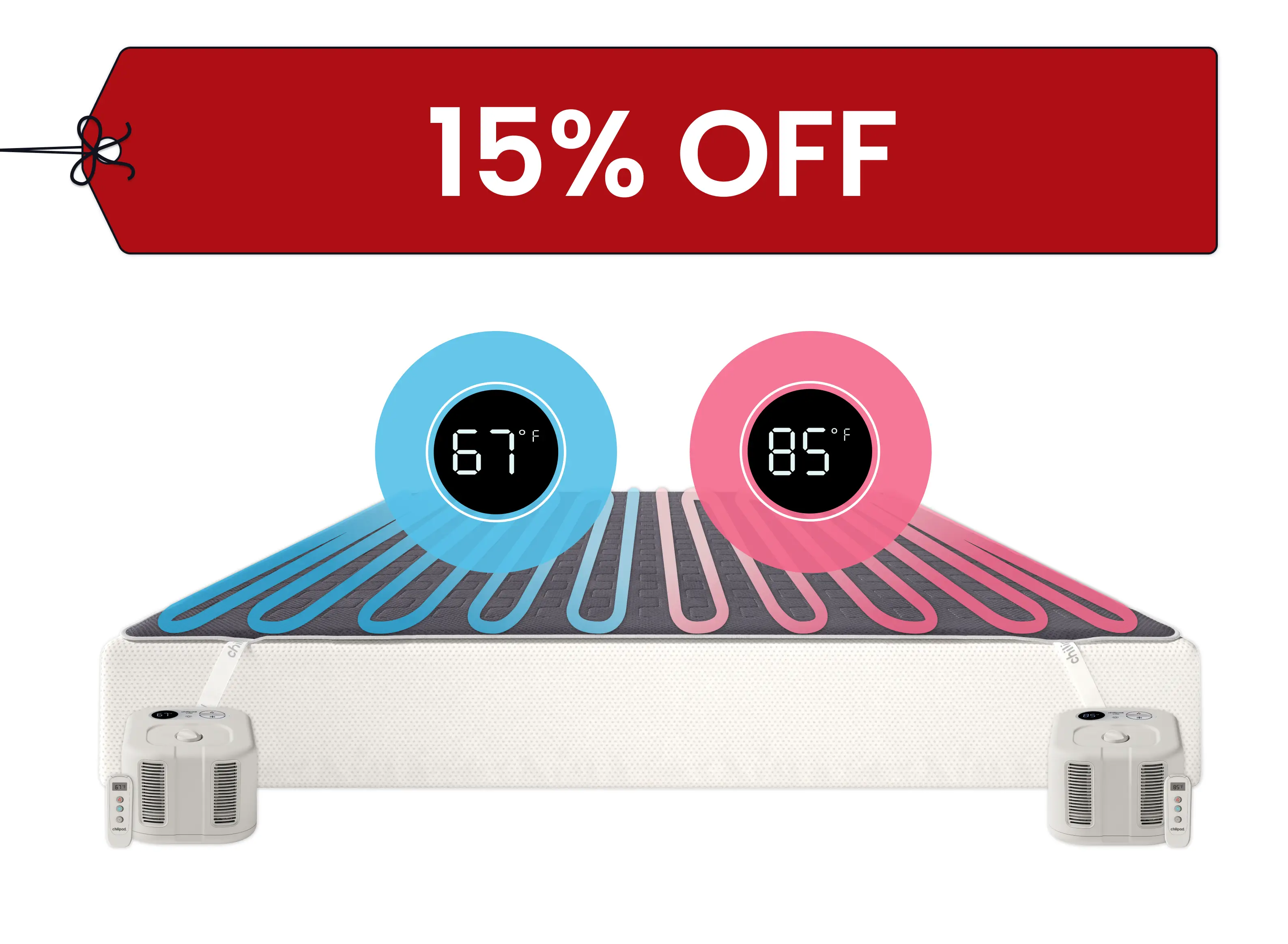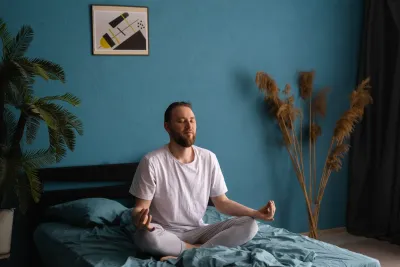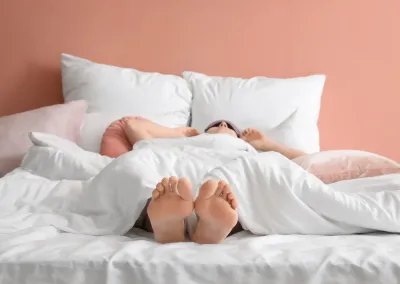Can a White Noise Machine Help You Sleep? Benefits & Tips
Ana Marie Schick: Resident Sleep Expert & Certified Health Coach • Jan 10, 2025

Key Takeaways
- Sound Shield: White noise helps block out distractions—traffic, snoring, late-night chatter—so your brain stays in sleep mode.
- Sleep Boost: Studies show it can cut the time it takes to fall asleep by nearly 40%, especially in noisy settings.
- Easy Access: Fans, apps, or sound machines, there are plenty of ways to work white noise into your routine.
- Keep Sound Low: Aim for under 50 decibels. Enough to soothe, not enough to keep your brain on high alert.
- Personal Call: Not everyone uses it. Try it for a few nights and see if the steady hum works for you.
Nothing beats waking up refreshed and ready to go. But miss out on sleep for even a few nights, and the fallout is real—foggy focus, short tempers, and that drained, groggy feeling that ruins both workdays and time with the people you care about.
In the quest for better sleep, nearly 38% of people turn to white noise or other sounds to help them sleep, according to a Newsweek survey. [1] The concept isn’t new—back in the 17th century, Gian Lorenzo Bernini, while exploring ways to treat insomnia, created what’s considered the first white noise machine. Turns out, soothing sound has been a sleep hack for centuries.
A multitude of apps and white noise machines are available. People often use their humidifiers or air conditioning to generate white noise. Recorded stretches of 8-plus hours of white noise can be accessed online.
So, what is white noise anyway? What’s the most helpful way to use them? Most significantly, is there credible science to back it up?
Below, you’ll find those answers and more to help you make well-informed decisions about your sleep needs.
What is White Noise?
Think of white noise like a sound smoothie—it blends all the audible frequencies your ears can pick up and mixes them at equal intensity. The result? A steady, consistent hum that helps drown out other noises.
That’s why it’s often called “broadband” sound—it covers a wide range of pitches, creating a calming background that helps your brain tune out distractions and stay focused (or asleep).
What does white noise sound like? People say it’s similar to an untuned radio or TV sound. Some may compare the background noise to a “shh” or hissing sound. [2] [3]
Not sure if white noise is your thing? Give it a listen and find out.
The Spectrum of Noise Colors
The spectrum of noise colors is a fascinating range of sounds that vary in frequency and intensity, each with unique characteristics and effects on the human brain. The Spectrum of Noise Colors
There are different types of colored noises; understanding these differences can help you choose the right sound to improve your sleep quality.
- White Noise: A steady, static-like sound that covers all frequencies equally. Think: a fan, AC hum, or TV static. Great for masking background noise and creating a consistent soundscape for sleep.
- Pink Noise: Softer and more balanced than white noise, with more emphasis on lower frequencies. Pink noise sounds like rain, ocean waves, or rustling leaves. Known to enhance relaxation and sleep quality.
- Brown Noise: Also called red noise, it’s deeper and richer than pink or white noise. Think thunder, waterfalls, or heavy rain. Brown noise is deal for drowning out low-frequency sounds and promoting deep sleep.
- Green Noise: Found in nature, with mid-range frequencies that resemble crashing waves or rustling trees. Green noise is soothing, less abrasive option than traditional white noise.
- Blue Noise: A high-pitched sound that intensifies with frequency. It’s like hissing pipes or screeching brakes—less common for sleep but may be helpful in specific cases.
- Violet Noise: Even more intense at high frequencies than blue noise. Think piercing squeals or sharp screeches. Not sleep-friendly for most, but some studies link it to improved sleep and reduced insomnia.
- **Grey Noise: **Engineered to sound equally loud across all frequencies to the human ear. Balanced and neutral, like soft wind or whispering. A good fit for those sensitive to more intense noise types.
How Does White Noise Work?
White noise doesn’t just make sound, it works with your brain to protect your sleep. Here’s how:
- Sound Shielding: White noise creates a steady, unchanging sound that masks sudden noises—like footsteps from the apartment above or the TV blaring downstairs. This makes it harder for those disruptions to wake you up. [4]
- Raises Your Brain’s “Auditory Threshold”: The consistent hum of white noise reduces the sharp contrast between background silence and unexpected sounds (like a barking dog). This makes those noises feel less jarring—and less likely to pull you out of sleep.
- Prevents Sleep Interruptions: With fewer abrupt changes in noise levels, your brain’s arousal system (especially the cerebral cortex) is less likely to react. That means fewer unwanted awakenings and more uninterrupted rest. [5]
Did You Know: Separated from masking unwanted noise, soothing sounds can also encourage relaxation. Much like how a warm bath preps your body for sleep, soothing sounds in calming your mind. [6]
Benefits of White Noise: Scientific Research
Sleep scientists, public health experts, and neurologists have extensively researched white noise's benefits and values. Many clinical studies have found that white noise effectively enhances the amount of sleep and quality we get each night.
Other studies have also confirmed that white noise benefits can positively impact tinnitus, sleep onset latency, and lowered night awakenings, resulting in a good night's sleep.
Sleep Onset Latency
Sleep onset latency refers to the time it takes to proceed from wakefulness to the initial stages of sleep. It involves how long it takes you to fall asleep. For adults, typical sleep latency varies between 10 and 20 minutes.
The appropriate amount of sleep latency influences overall sleep efficiency, meaning more time in bed is spent sleeping versus lying awake. [7] [8]
Evidence indicates sleeping with white noise is beneficial for helping someone fall asleep faster in a high-noise environment such as New York City. [9] Sleep onset latency also improved for a group of healthy college students using broadband/white noise, which improves sleep by masking disruptive sounds. [10]
Nighttime Arousals
Interrupted sleep patterns experienced regularly by hospitalized patients concern many healthcare professionals in a study on improving patients' sleep in a noisy intensive care unit (ICU), white noise machines significantly reduced nighttime arousals.
Furthermore, the arousals decreased substantially even when the study participants were exposed to peak noise levels (greater than 65 decibels). [11] Another study of patients hospitalized in a coronary care unit yielded comparable results. [12]

May Help with Tinnitus
White noise may be helpful for someone with tinnitus. [13] Tinnitus is a condition described as a strange ringing or buzzing in the ear. White noise can help mask the sound, which leans to be disruptive and more prominent at night when it's quiet.
Safety & Effectiveness
If you’re using noise colors to improve your sleep, it’s worth considering both the safety and the results. Here are a few things to keep in mind:
Volume Control
Keep the volume at a comfortable level. Make sure it's loud enough to block distractions, but not so loud that it becomes a distraction. If it's loud for long periods, it can damage hearing, so aim for balance.
Individual Preferences
The sound of white noise isn’t one-size-fits-all. Test it out (and other noise colors) with volume levels to see what works for you. What soothes one person to sleep might keep someone else wide awake.
Sleep Quality
Noise colors can improve your sleep by blocking background noise, easing your mind, and creating a steady sleep environment. The payoff? Falling asleep faster and staying asleep more consistently
Sleep Routine
Including such sounds in your bedtime routine is like giving your brain a gentle nudge that says, “hey, it’s bedtime.” Pairing them with a consistent routine, such as the same lights out and rituals, helps set the stage for better sleep habits and a better sleep hygiene.
Environmental Noise:
White noise does a great job of blocking out the chaos while sleeping. Whether it’s traffic outside, a snoring partner, or the general buzz of a busy household. White noise is ideal if you live in a city or anywhere background noise tries to disrupt your sleep.
Stable Sleep
White noise helps you fall asleep faster and stay there by smoothing out the bumps that usually wake you up. Brown noise, sometimes called red noise, takes it further, boosting sleep quality and even easing insomnia symptoms for some people.
Better Sleep
White noise and its colorful counterparts create a steady backdrop that helps drown out distractions, promotes relaxation, and maintains a consistent sleep environment. The payoff? Higher-quality rest and nights that actually feel restorative.
High Noise Environment
In loud environments, white noise can be particularly effective in helping you fall asleep and stay asleep. They can mask disruptive sounds and create a more peaceful sleep environment.
Sleep Onset Latency
It can help reduce sleep onset latency, making it easier to fall asleep. This can help people who struggle with falling asleep.

Choosing What Works for You to Improve Sleep
The million-dollar question: does white noise help you sleep? Sleep scientists, physicians, and public health professionals see white noise as one of the many techniques available to provide high-quality sleep and the development of a healthy lifestyle.
If you choose to try white noise, select a comfortable volume level, such as the level of a soft shower. Remember that white noise is only one tool in the selection of sleep hygiene strategies.
Below are just a few of the many alternatives available:
- Sleep Environment: Create a cozy sleep environment by keeping a cool, dark, decluttered bedroom.
- Sleep Schedule: Maintain a consistent sleep schedule, including a wake schedule, even on non-work days.
- Helpful Foods: Explore foods that can help improve your sleep.
- Bedtime Yoga: Practice Yoga Nidra, a bedtime yoga routine.
- Bedroom Temperature: Sleep cooler with comprehensive bed cooling system and mattress pad.
- Drinks for Better Sleep: Discover drinks that can improve your sleep quality.
Final Thought
Beyond white, pink, and brown noise, sounds like ocean waves can also be an effective non-pharmacological sleep aid, working to help you sleep and block out annoying noises and external disturbances. [14] Adjusting the volume might require a little trial-and-error.
Ultimately, however, you'll discover if white noise, pink noise, brown noise, or the calming rhythm of ocean waves enhances your sleep quality.
Frequently asked questions
Who Benefits Most From Using White Noise?
White noise can be especially helpful for light sleepers, shift workers, people with tinnitus, and children who have trouble falling or staying asleep.
Can White Noise Help Me Sleep?
Yes, white noise can be very helpful for improving sleep. It works by masking distracting sounds like traffic, sirens, or even snoring. This consistent background noise can help you fall asleep faster and stay asleep longer by creating a more peaceful and consistent soundscape.
Is a Fan Considered White Noise?
Yes, the sound of a fan can be considered a form of white noise. While not as consistent or predictable as a dedicated white noise machine, the steady hum of a fan can effectively mask sleep disturbances like traffic, snoring, and other sounds helping you fall asleep faster and stay asleep longer.
Are There Other Types of “Colored” Noise Besides White Noise?
Yes! In addition to white noise, there are other types, including:
- White Noise: Even distribution of frequencies; masks sounds well.
- Pink Noise: Stronger low frequencies; sounds like steady rain or wind.-
- Brown Noise: Deep, low-frequency sound; similar to thunder or a distant waterfall.
- Blue Noise: Higher-pitched sound; more stimulating than soothing.
- Green Noise: Mimics natural environments like ocean waves or rustling leaves.
Is It Good for You to Sleep with White Noise?
Yes, It works by drowning out sudden sounds with a steady hum, helping your brain relax and stay asleep longer. Research backs it up—white noise can help you fall asleep faster and improve sleep quality. Whether it's a fan, app, or sound machine, just keep the volume low enough to protect your ears while you sleep.
References
[1] Riva, M.A., Cimino, V., Sanchirico, S. (2017, October 1). Gian Lorenzo Bernini's 17th century white noise machine. [abstract]. The Lancet, Neurology, 16(10), 776 View Study
[2] Summer, J. (2022, March 11) White Noise. Sleep Foundation. View Resource
[3] Vinall, M. (2021, August 27). Why white noise may help you get the best sleep ever. Healthline. View Resource
[4] Ibid.
[5] Farokhnezhad Afshar P, Bahramnezhad F, Asgari P, Shiri M. Effect of white noise on sleep in patients admitted to a coronary care. J Caring Sci 2016; 5 (2): 103-9. View Study
[6] Farokhnezhad Afshar, Pouya et al. “Effect of White Noise on Sleep in Patients Admitted to a Coronary Care.” Journal of caring sciences vol. 5,2 103-9. 1 Jun. 2016, doi:10.15171/jcs.2016.011. View Study
[7] Stanchina, M. L., Abu-Hijleh, M., Chaudhry, B. K., Carlisle, C. C., & Millman, R. P. (2005). The influence of white noise on sleep in subjects exposed to ICU noise. Sleep Medicine, 6(5), 423–428. View Study
[8] Messineo L, Taranto-Montemurro L, Sands SA, Oliveira Marques MD, Azabarzin A and Wellman DA (2017) Broadband Sound Administration Improves Sleep Onset Latency in Healthy Subjects in a Model of Transient Insomnia. Front. Neurol. 8:718.
[9] Ebben, M.R., Yan, P., Kriedger, A.C.(2021) The effects of white noise on sleep and duration in individuals living in a high noise environment in New York City. Sleep Medicine V. 83, 256-259 Abstract. View Resource
[10] Messineo L, Taranto-Montemurro L, Sands SA, Oliveira Marques MD, Azabarzin A and Wellman DA (2017) Broadband Sound Administration Improves Sleep Onset Latency in Healthy Subjects in a Model of Transient Insomnia. Front. Neurol. 8:718.
[11] Farokhnezhad Afshar P, Bahramnezhad F, Asgari P, Shiri M. Effect of white noise on sleep in patients admitted to a coronary care. J Caring Sci 2016; 5 (2): 103-9. View Study
[12] Barozzi, S., Ambrosetti, U., Callaway, S. L., Behrens, T., Passoni, S., & Bo, L. D. (2017). Effects of Tinnitus Retraining Therapy with Different Colours of Sound. The international tinnitus journal, 21(2), 139–143. View Study
[13] Yoon, H. & Baek, H.J. (2022). External auditory stimulation as a non-pharmacological sleep aid. Sensors, 22, 1264. View Study [14] Summer, J. (2022, March 11) White Noise. Sleep Foundation. View Resource








